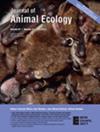Marine heatwaves imperil emblematic reef fishes by altering the energetic landscape of coral reefs
IF 3.7
1区 环境科学与生态学
Q1 ECOLOGY
引用次数: 0
Abstract



海洋热浪通过改变珊瑚礁充满活力的景观,威胁着标志性的珊瑚礁鱼类。
由于人为引起的气候变化,海洋热浪越来越普遍。在长期的热应力作用下,珊瑚礁会发生白化,导致大量珊瑚死亡和底栖生物群落组成的大规模变化。虽然珊瑚死亡对身体状况和依赖珊瑚的鱼类种群有明显的负面影响,但驱动这些变化的机制仍未得到充分解决。具体而言,珊瑚白化对以下方面的影响知之甚少:(1)珊瑚的营养质量;(2)以珊瑚为食的蝴蝶鱼的营养获取;(3)鱼类的膳食选择和对非珊瑚猎物的潜在补充消费。在这里,我们评估了专性珊瑚捕食蝴蝶鱼对法属波利尼西亚大规模珊瑚白化事件的反应,该事件导致珊瑚死亡率高,专性珊瑚密度下降50%。我们研究了二十年来底栖动物和蝴蝶鱼的群落组成,包括2019年的大规模白化事件和多次先前的干扰。我们将这些数据与蝴蝶鱼的摄食选择性调查、高分辨率的肠道内容物分子分析和漂白事件之前、期间和之后的营养获取相结合。与以往的研究相反,专性珊瑚动物并没有强烈地改变它们对不同珊瑚属的摄食偏好。由于珊瑚的死亡,它们并没有增加对非珊瑚的消耗,而硬珊瑚继续主导它们的饮食(约90%)。相反,蝴蝶鱼的目标是部分漂白的珊瑚,这些珊瑚可能会释放出富含营养的粘液,它们会避开完全漂白的珊瑚和可能营养耗尽的死珊瑚。此外,在漂白后,蝴蝶鱼表现出氮同化减少,表明珊瑚胁迫可能对蝴蝶鱼的营养获取产生不利影响。再加上珊瑚白化事件的频繁发生,珊瑚白化对蝴蝶鱼种群的严重、长期的营养影响可能会危及未来以珊瑚为食的鱼类的持久性。
本文章由计算机程序翻译,如有差异,请以英文原文为准。
求助全文
约1分钟内获得全文
求助全文
来源期刊

Journal of Animal Ecology
环境科学-动物学
CiteScore
9.10
自引率
4.20%
发文量
188
审稿时长
3 months
期刊介绍:
Journal of Animal Ecology publishes the best original research on all aspects of animal ecology, ranging from the molecular to the ecosystem level. These may be field, laboratory and theoretical studies utilising terrestrial, freshwater or marine systems.
 求助内容:
求助内容: 应助结果提醒方式:
应助结果提醒方式:


